Superoxide generated at mitochondrial complex III triggers acute responses to hypoxia in the pulmonary circulation
- PMID: 23328522
- PMCID: PMC3603595
- DOI: 10.1164/rccm.201207-1294OC
Superoxide generated at mitochondrial complex III triggers acute responses to hypoxia in the pulmonary circulation
Abstract
Rationale: The role of reactive oxygen species (ROS) signaling in the O(2) sensing mechanism underlying acute hypoxic pulmonary vasoconstriction (HPV) has been controversial. Although mitochondria are important sources of ROS, studies using chemical inhibitors have yielded conflicting results, whereas cellular models using genetic suppression have precluded in vivo confirmation. Hence, genetic animal models are required to test mechanistic hypotheses.
Objectives: We tested whether mitochondrial Complex III is required for the ROS signaling and vasoconstriction responses to acute hypoxia in pulmonary arteries (PA).
Methods: A mouse permitting Cre-mediated conditional deletion of the Rieske iron-sulfur protein (RISP) of Complex III was generated. Adenoviral Cre recombinase was used to delete RISP from isolated PA vessels or smooth muscle cells (PASMC).
Measurements and main results: In PASMC, RISP depletion abolished hypoxia-induced increases in ROS signaling in the mitochondrial intermembrane space and cytosol, and it abrogated hypoxia-induced increases in [Ca(2+)](i). In isolated PA vessels, RISP depletion abolished hypoxia-induced ROS signaling in the cytosol. Breeding the RISP mice with transgenic mice expressing tamoxifen-activated Cre in smooth muscle permitted the depletion of RISP in PASMC in vivo. Precision-cut lung slices from those mice revealed that RISP depletion abolished hypoxia-induced increases in [Ca(2+)](i) of the PA. In vivo RISP depletion in smooth muscle attenuated the acute hypoxia-induced increase in right ventricular systolic pressure in anesthetized mice.
Conclusions: Acute hypoxia induces superoxide release from Complex III of smooth muscle cells. These oxidant signals diffuse into the cytosol and trigger increases in [Ca(2+)](i) that cause acute hypoxic pulmonary vasoconstriction.
Figures
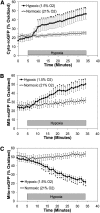
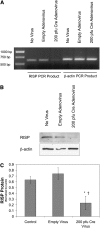
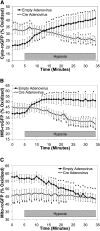
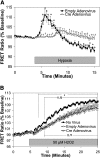
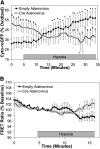
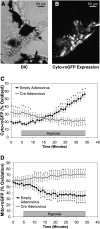
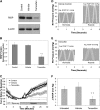

Comment in
-
Mitochondria in hypoxic pulmonary vasoconstriction: potential importance of compartmentalized reactive oxygen species signaling.Am J Respir Crit Care Med. 2013 Feb 15;187(4):338-40. doi: 10.1164/rccm.201301-0037ED. Am J Respir Crit Care Med. 2013. PMID: 23418325 Free PMC article. No abstract available.
Similar articles
-
Important Role of Sarcoplasmic Reticulum Ca2+ Release via Ryanodine Receptor-2 Channel in Hypoxia-Induced Rieske Iron-Sulfur Protein-Mediated Mitochondrial Reactive Oxygen Species Generation in Pulmonary Artery Smooth Muscle Cells.Antioxid Redox Signal. 2020 Mar 1;32(7):447-462. doi: 10.1089/ars.2018.7652. Epub 2019 Oct 11. Antioxid Redox Signal. 2020. PMID: 31456413 Free PMC article.
-
Endoplasmic reticulum Ca2+ release causes Rieske iron-sulfur protein-mediated mitochondrial ROS generation in pulmonary artery smooth muscle cells.Biosci Rep. 2019 Dec 20;39(12):BSR20192414. doi: 10.1042/BSR20192414. Biosci Rep. 2019. Retraction in: Biosci Rep. 2020 Apr 30;40(4):BSR-20192414_RET. doi: 10.1042/BSR-20192414_RET. PMID: 31710081 Free PMC article. Retracted.
-
Important role of PLC-γ1 in hypoxic increase in intracellular calcium in pulmonary arterial smooth muscle cells.Am J Physiol Lung Cell Mol Physiol. 2013 Feb 1;304(3):L143-51. doi: 10.1152/ajplung.00310.2012. Epub 2012 Nov 30. Am J Physiol Lung Cell Mol Physiol. 2013. PMID: 23204067 Free PMC article.
-
Cross Talk Between Mitochondrial Reactive Oxygen Species and Sarcoplasmic Reticulum Calcium in Pulmonary Arterial Smooth Muscle Cells.Adv Exp Med Biol. 2017;967:289-298. doi: 10.1007/978-3-319-63245-2_17. Adv Exp Med Biol. 2017. PMID: 29047093 Review.
-
Mitochondrial Rieske iron-sulfur protein in pulmonary artery smooth muscle: A key primary signaling molecule in pulmonary hypertension.Arch Biochem Biophys. 2019 Mar 30;664:68-75. doi: 10.1016/j.abb.2019.01.029. Epub 2019 Jan 30. Arch Biochem Biophys. 2019. PMID: 30710505 Review.
Cited by
-
Acute oxygen sensing by vascular smooth muscle cells.Front Physiol. 2023 Mar 3;14:1142354. doi: 10.3389/fphys.2023.1142354. eCollection 2023. Front Physiol. 2023. PMID: 36935756 Free PMC article. Review.
-
Redox signaling in pathophysiology of hypertension.J Biomed Sci. 2013 Sep 18;20(1):69. doi: 10.1186/1423-0127-20-69. J Biomed Sci. 2013. PMID: 24047403 Free PMC article. Review.
-
Mitochondrial GSH Systems in CA1 Pyramidal Cells and Astrocytes React Differently during Oxygen-Glucose Deprivation and Reperfusion.ACS Chem Neurosci. 2018 Apr 18;9(4):738-748. doi: 10.1021/acschemneuro.7b00369. Epub 2017 Dec 14. ACS Chem Neurosci. 2018. PMID: 29172440 Free PMC article.
-
ROS and cGMP signaling modulate persistent escape from hypoxia in Caenorhabditis elegans.PLoS Biol. 2022 Jun 21;20(6):e3001684. doi: 10.1371/journal.pbio.3001684. eCollection 2022 Jun. PLoS Biol. 2022. PMID: 35727855 Free PMC article.
-
Chronic Obstructive Pulmonary Disease and the Cardiovascular System: Vascular Repair and Regeneration as a Therapeutic Target.Front Cardiovasc Med. 2021 Apr 12;8:649512. doi: 10.3389/fcvm.2021.649512. eCollection 2021. Front Cardiovasc Med. 2021. PMID: 33912600 Free PMC article. Review.
References
-
- Rounds S, McMurtry IF. Inhibitors of oxidative ATP production cause transient vasoconstriction and block subsequent pressor responses in rat lungs. Circ Res 1981;48:393–400 - PubMed
-
- McMurtry IF. Angiotensin is not required for hypoxic constriction in salt solution-perfused rat lungs. J Appl Physiol 1984;56:375–380 - PubMed
-
- Grimminger F, Weissmann N, Spriestersbach R, Becker E, Rosseau S, Seeger W. Effects of NADPH oxidase inhibitors on hypoxic vasoconstriction in buffer-perfused rabbit lungs. Am J Physiol 1995;268:L747–L752 - PubMed
-
- Weissmann N, Grimminger F, Voswinckel R, Conzen J, Seeger W. Nitro blue tetrazolium inhibits but does not mimic hypoxic vasoconstriction in isolated rabbit lungs. Am J Physiol 1998;274:L721–L727 - PubMed
-
- Weissmann N, Grimminger F, Walmrath D, Seeger W. Hypoxic vasoconstriction in buffer-perfused rabbit lungs. Respir Physiol 1995;100:159–169 - PubMed
Publication types
MeSH terms
Substances
Grants and funding
LinkOut - more resources
Full Text Sources
Other Literature Sources
Molecular Biology Databases
Miscellaneous

